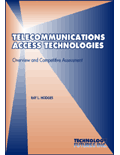
Telecommunications Access Technologies
Ray L. Hodges
[ordering online? -- please see our return/refund policy]
 |
Telecommunications Access Technologies |
This new report from Technology Futures provides a good, concise overview of the competitive access technologies that will impact the local exchange network.
It is inevitable that incumbent local exchange carriers will lose significant market share within their franchise boundaries. The competing technologies -- terrestrial wireless, satellite, or cable -- are simply more economical than the ILECs' circuit switched, copper-based network for multimedia services and will become more economical for voice as their market share declines. It is also now economically practical for multiple competitors to provide fiber facilities in core business districts. Additionally, continued improvements in fiber optic technology and newly available millimeter wave radio systems (i.e., wireless fiber) extend the reach of competitive providers even further to include smaller cities and businesses. The ILECs' natural response to their competition is to expand beyond their franchise boundaries as full-service competitive local exchange carriers or by acquisitions. This, in turn, results in more competition for the other ILECs.
This Comprehensive Report
- Analyzes the competitive threat to local exchange carriers from competing technologies that will provide either voice or data services.
- For ease-of-use and comparison, outlines the state of each technology, the key application areas and special strengths, weaknesses and limitations, key providers and users, market size, and forecasts of the technology adoption.
- Provides an assessment and opinion as to the direction of the industry.
Key Findings From This Latest TFI Report [back to top]
Includes Analysis and Forecasts of:
- Analog, cellular, digital cellular/PCS, 2.5, and 3rd generation wireless
- Cable modems
- Cable voice
- Fiber-based CLECs
- MMDS and LMDS
- VSATs
- Two generations of LEOs (Narrowband and Broadband)
Who should read this report? [back to top]
Table of Contents [back to top]
- Chapter One: The Telecommunications Landscape
- The Technologies
- The Competition
- The Costs
- Chapter Two: Traditional Wireline Telephone Network
- Chapter Three: Terrestrial Wireless
- Cellular, PCS, 2.5 Generation, and 3rd Generation
- Personal Communication Services (PCS)
- Multichannel Multipoint Distribution Services (MMDS)
- Local Multipoint Distribution Service (LMDS)
- Wireless Fiber
- Other Wireless
- Chapter Four: Cable Networks
- Chapter Five: Fiber-Based Competitors
- Chapter Six: Satellites
- Direct Broadcast Satellites (DBS)
- Very Small Aperture Terminals (VSATs)
- Narrowband LEOs
- Broadband LEOs
- Appendices
- A. Notes to Exhibits 5.2 and 5.3
- B. List of Selected Cities and Localities Served by CAPs
- C. Iridium Investment Partners
- List of Acronyms
List of Exhibits [back to top]
1.1 Copper's Competition 2.1 Adoption of Interoffice SONET Equipment 2.2 Adoption of Loop SONET Equipment 2.3 Local Exchange Network Architecture 2.4 Cost of Wireline vs. Market Share 2.5 Switching Technology Shares
-- Late ATM Scenarios2.6 Adoption of Interoffice SONET 2.7 Adoption of Loop SONET 2.8 Digital Service Availability on Fiber
-- All Households & Business Locations3.1 Diagrammic Cellular Cluster Frequency Pattern 3.2 Cellular Telephone Network Architecture 3.3 Next-Generation Wireless Systems 3.4 Wireless Subscribers by Technology 3.5 Top 10 Licenses Ranked by Total
Population Across Markets3.6 Top 25 Wireless Companies in Terms of
Actual Subscribers3.7 Wireless Market Make-Up 3.8 U.S. Cellular/PCS Subscribers -- Percentage of U.S.
Population Age 15 and Older3.9 U.S. Cellular/PCS Subscribers 3.10 U.S. Cellular/PCS Subscribers (Table) 3.11 Basic LMDS NEtwork Architecture 3.12 Top LMDS Bidders 3.13 LMDS U.S. Business Service Market 4.1 Traditional Cable TV Network Tree and
Branch Architecture4.2 Hybrid Fiber/Coax Cable TV system 4.3 Households Using Digital Services 4.4 Cable Modems Addressable Market Size 4.5 Gompertz Forecast for Cable Modems 4.6 Gompertz Forecast for Cable Modems (Table) 4.7 Gompertz Forecast for Cable Voice Subscribers 4.8 Gompertz Forecast for Cable Voice
Subscribers (Table)5.1 Network Carrier SONET/SDH Peak
Transmission Rate vs. Time5.2 Competitive Access Fiber Systems,
Other Available Data -- 19975.3 Competitive Access Fiber Systems -- 1997 5.4 Fiber Miles 5.5 Percentage Growth in Fiber Systems 6.1 SCPC Broadcast Network 6.2 Bi-Directional Data TDMA Networks 6.3 DAMA Network 6.4 Frequency Allocation for Non-Geostationary
Satellite Services6.5 Iridium Systems Overview 6.6 Facts about the Iridium Constellation 6.7 Celestri LEO System Architecture 6.8 Multimedia Communications Market Growth 6.9 U.S. Residential Broadband Satellite
Subscriber Forecast
Pricing Information [back to top]
March 2000, 98 pages, Sponsored by the TTFG, ISBN 1-884154-13-1
Texas residents add 7.25% (Austin, Texas 8.25%) sales tax.
All orders are shipped via UPS ground
Call for TTFG member prices and volume discounts.